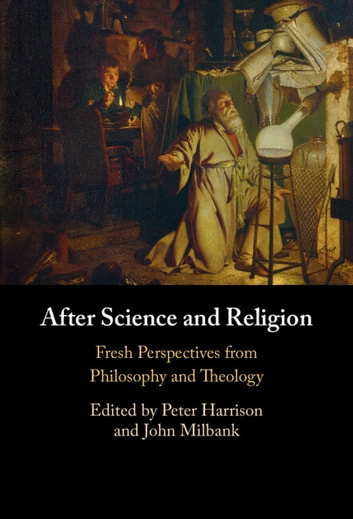Book review by Robert Brennan
After Science and Religion: Fresh Perspectives from Philosophy and Theology
By Peter Harrison and John Milbank (eds.)
Australia: Cambridge University Press, 2022; 330 pages.
ISBN 9781316517925, 1st edition, hardcover
AUD$169.95
Co-editor, Peter Harrison, is an Australian Laureate Fellow and Director of the Institute for Advanced Studies in the Humanities at the University of Queensland. He was the Idreos Professor of Science and Religion at the University of Oxford. He is an ISCAST fellow. He has published extensively in the field of relations between science and religion. The most recent of his six books is The Territories of Science and Religion. Many of the contributors to After Science and Religion develop themes from The Territories of Science and Religion.
Co-editor, John Milbank, is Emeritus Professor in the Department of Theology and Religious Studies at the University of Nottingham, where he is President of the Centre of Theology and Philosophy. Milbank founded the radical orthodoxy movement. His work crosses disciplinary boundaries, integrating subjects such as systematic theology, social theory, ethics, aesthetics, philosophy, political theory, and political theology. Milbank delivered the Stanton Lectures at Cambridge in 2011.
This book builds on Harrison’s Territories of Science and Religion with contributions from thirteen leading historians, theologians, scientists, and philosophers.
It is very difficult to summarise this book without risking misrepresenting it. Perhaps it is best to summarise it in the words of its contributors. John Milbank states “The aim of the new ‘After Science and Religion’ project is to call into question an entire existing intellectual discourse and to try to forge a new one in its place. … The existing discourse tends to assume that there have more or less always, or for a very long time, existed discrete realms called ‘science’ and ‘religion’” (p. 102).
The late Tom McLeish states, “The commonly accepted historical narrative that ‘science and religion’ inhabit a context of ‘conflict’ or ‘warfare’ is deeply flawed. … But in the late modern era, questions surrounding science and theology have been largely confined to the field of apologetics, with various degrees of warmth attributed to different possible constructed relationships between the two categories (or alternative epistemologies)” (p. 324).
McLeish proposes the “direct test of this set of narratives would be to put twenty-first century scientists into direct contact with the natural philosophy of the thirteenth” (p. 327). Many of the contributors note that Harrison called into question that the terms science and religion as commonly accepted contribute to an “illicit reification” of the terms. That is, they are falsely considered historically fixed things that are clearly classified. The reality is complex and fluid. Though, as Harrison admits, the complexity thesis has not gained traction and has little to commend itself other than being true.
Many of the contributors trace the sometimes-strange historical antecedents of the terms “science” and “religion” more broadly and further back in time than Harrison’s Territories. These antecedents inhabit a context of “conflict” or “warfare” that is deeply flawed. Lightman examines dead ends in nineteenth-century theology. Milbank examines the contribution of hermetic or magical thinking in the high Middle Ages. Pickstock examines the influence of some fourteenth and fifteenth-century scholars on the development of later science-like thinking. Her description of Lady Ann Conway who later influenced Leibniz is quite informative. McLeish compares contemporary narratives of science against the natural philosophy of the thirteenth century with interesting results.
The breadth of the contributions is significant. Even experts in this field will be stretched with new concepts, people, and ideas. This book will challenge and stretch all readers in a good way. Nevertheless, David Bentley Hart and John Milbank need to be read with a good dictionary at hand. As well as being worth reading as usual, they are as challenging to read as they are profound.
The book points to possible ways forward in the interaction between science and religion. The contributors do not claim to have found a way. Instead, we are challenged to think about why we do what we do. For those at the science-theology interface, this is a good challenge to think about.
There are at least two dangers we are challenged to avoid. The first is the trap of thinking that the categories of science and religion are what “everyone” thinks, and becoming bound in our thinking by what we presume those categories are.
Schindler and a couple of other contributors point to the second problem outlined by Stephen Gaukroger in his Civilization and the Culture of Science: Science and the Shaping of Modernity: that there is a tendency from its “earliest beginnings in the thirteenth century of what would become ‘modern science’ for the enquiry into the natural world to present itself not just as ‘one cognitive discipline among many’ but as ‘the key to cognitive inquiry generally,’ and that that tendency became genuinely totalitarian already in the first properly modern pioneers of science” (p. 293).
This totalitarian dominance of “scientific reasoning” for everyone is highlighted by Williams, Hart, Hanby, Milbank, and Harrison. Perhaps the difficulty in finding a way forward is best demonstrated in Milbank’s otherwise excellent chapter. Milbank argues that medieval traditions of magical reasoning influenced the later development of what would become science. Milbank’s own argument is dominated by scientific reasoning. At one point he incorrectly reasons that the “established” scientific law, that the speed of light is a fixed barrier, means that quantum entanglement contracts science and is somehow magic.
This is an excellent book. It is an advanced text and so not necessarily for those new to the interaction between science and religion. It is an important text for all of us who have a serious interest in the field and are concerned with how we move into the future.

